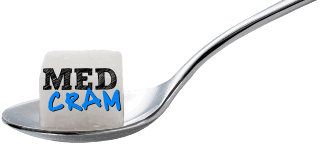Flipping the classroom
In this video, Dr. Seheult from MedCram interviews Dr. Rishi Desai from Osmosis and explores flipping the classroom. Per Dr. Seheult, he is one of the original pioneers of flipping the classroom during his work with Khan Academy. Dr. Desai discusses how he feels the best doctors are those who come up with pertinent questions that can then be researched and answered.
Dr. Seheult reminisces how he used to teach pulmonology at Loma Linda University Medical Center and students would be in lecture for 4 hours during which time he primarily went over different aspects of pulmonology. Now, however, he has the lectures online that students can preview ahead of the class. When he comes in to lecture subsequently, the students do a type of online Jeopardy questioning and then go to a simulation lab. Here the students, along with Dr. Seheult, manage a patient in a simulation lab and scrutinize the case. However, a drawback to this is that some students don’t review the material prior to coming to the classroom.
Dr. Desai concurs this is an issue and some innovative solutions have included professors meeting up with students in a more social setting to discuss a topic with the premise that if a student is going to come to this event, he/she would have reviewed the lecture materials prior to coming to the meetup. Furthermore, Dr. Desai believes that changing the location from the standard classroom setting also initiates a different response from the students where students will want to be better prepared before facing their professors. Dr. Seheult notes that this concept of flipping the classroom is about engagement and getting students involved in a pattern of lifelong learning.
New research on flipping the classroom
A new research study from the BMC Medical Education Journal used a flipped classroom model and compared it to a traditional teaching model in tutoring evidence-based medicine skills. There were a total of 90 students enrolled and assigned to either the experimental (flipped classroom model) or control (traditional classroom model) group.
The results showed that compared to the traditional teaching methods, the flipped classroom model had improved learning outcomes for the evidence-based medicine categories of Ask, Acquire, Appraise, and Apply for both the written and oral tests at the end of the course. All of the p-values were statistically significant. The study found that the Appraise skill for the written test and the Apply skill for the oral test had the largest difference between the two groups.
LINKS / REFERENCES:
BMC Medical Education: Implementing a flipped classroom model in an evidence-based medicine curriculum for pre-clinical medical students: evaluating learning effectiveness through prospective propensity score-matched cohorts
Medcram video: Flipping the Medical Classroom & New Hypertension (HTN) Guidelines – MedCram Interviews Osmosis , flipping the medical classroom discussion starts at 11:02 minute mark.
Stay Tuned for More COVID-19 Updates
Our COVID-19 videos are always available for free (and ad-free) at MedCram.com. In addition, check out our full library of courses and lectures on subjects ranging from Hypertension Explained Clearly to Sleep Apnea Explained Clearly Course and many more!
Meanwhile, you can find all of our COVID-19 videos compiled here.
